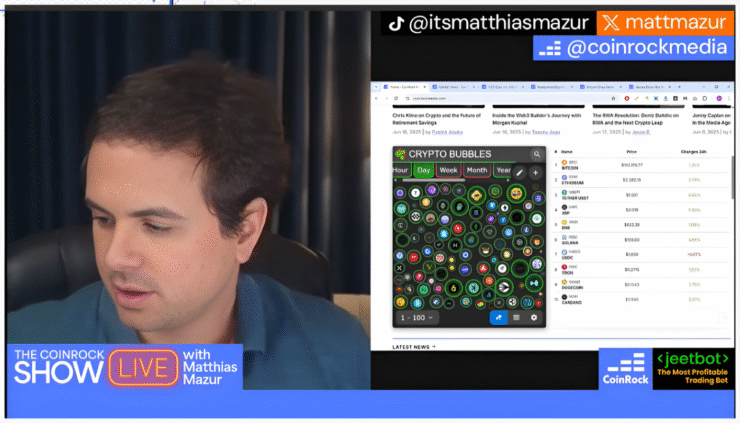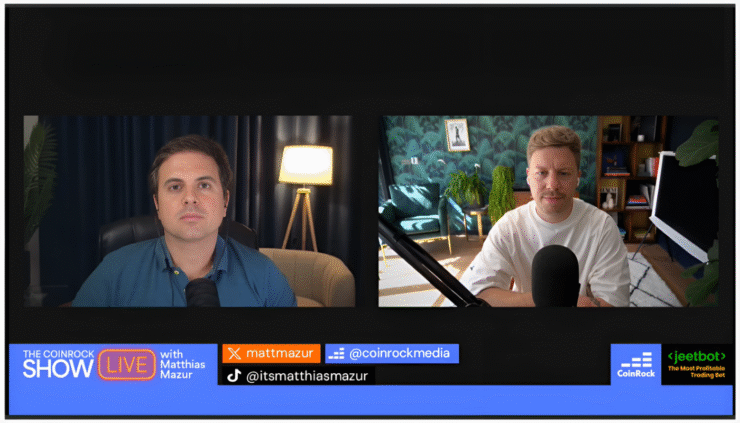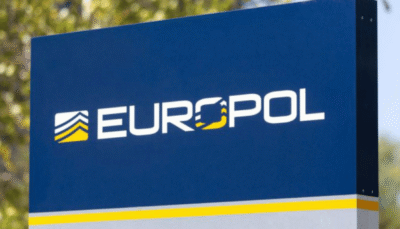This week’s CoinRock Show opened with Matthias in a light, improvisational mood as he reflected on what he called a “dead day” in crypto markets, underscoring how stagnant sentiment often hides the biggest opportunities.
“Crypto is dead today,” he quipped, before digging into the real reason: mounting geopolitical instability, particularly in the Middle East. With rising nuclear threats, deteriorating diplomacy, and a wave of political backpedaling from U.S. figures like Trump, JD Vance, and Tulsi Gabbard, Matthias struck a somber chord.
“I think everyone in the world wants peace,” he said, adding that the return of war narratives eerily mirrors the propaganda of the Iraq War era.
“This is 20 years in… Trump is Bush. Tulsi Gabbard is Colin Powell. It’s very annoying.”
He also lamented the state of the market, noting that Bitcoin had dropped from $111K to under $100K over the past week before slightly recovering. Ethereum had dipped as low as $2,100. The problem, as he framed it, isn’t just macro—it’s that uncertainty has pushed the entire market into a holding pattern.
“If we don’t see anything positive on the war/peace side… it’s going to be a bad summer price-wise.”
Still, amidst the chop, Matthias reminded listeners that this is precisely the kind of moment that demands clarity, long-term thinking, and strategic building. That’s why the timing felt right to bring on someone with a broader view of the crypto landscape—Kraken’s VP of Growth, Matthew Howells-Barby.

Enter Matthew Howells-Barby — The Growth Strategist Behind Kraken’s Global Push
When Matthew Howells-Barby joined the stream, Matthias wasted no time setting the tone. With a resume that spans early-stage SaaS success to deep crypto trenches, Matthew brought both historical context and future-facing insight.
Currently serving as the VP of Growth at Kraken—one of the industry’s oldest and most respected centralized exchanges—Matthew’s journey into crypto wasn’t overnight. He spent nearly a decade at HubSpot, where he helped scale the company’s marketing engine and rubbed shoulders with early Bitcoin adopters long before fully diving in himself. It wasn’t until 2016, after some hands-on exploration with Ethereum, that things began to click.
By 2017, he was all in.
“I spent a big chunk of my career in the software space when SaaS was a really sexy place to be,” he said, reflecting on his early path.
Since then, he’s worn multiple hats—CMO at Decentral Games during the GameFi boom, investor and advisor to crypto teams, and now a driving force behind Kraken’s global expansion.
His perspective is uniquely shaped by this full-stack experience: from Web2’s obsession with data to Web3’s pseudonymity problem, from DAOs without bank accounts to the real-world pressure of regulatory scrutiny.
“Kraken sits in this middle ground,” he explained.
“We’re centralized, yes, but we face compliance challenges on a completely different scale.”
Matthew joined Kraken just as the SEC launched its crackdown—trial by fire that taught him how every word, push notification, and web page is scrutinized by regulators worldwide. It’s a balancing act few can pull off: growth at scale, with compliance at the core.
And it’s that exact tension—between Web2 clarity, Web3 chaos, and institutional oversight—that formed the backbone of this episode’s conversation.
Inside Kraken’s Evolving Role
It didn’t take long for the conversation to turn toward regulation—and the unique position Kraken finds itself in. As Matthew put it, when you’re a major exchange operating in full view of global regulators, you’re a natural target.
“So it’s essentially, you are a big, big fish for any regulatory agency that wants to have a win,” Matthias said.
Matthew agreed, noting that Kraken’s role in the post-FTX landscape became even more crucial, not just for the market, but for restoring public trust.
“In many ways, centralized exchanges are a necessary evil,” Matthew admitted.
“They’re an important bridge in the long journey toward decentralized finance.”
That bridge, however, comes with mounting pressure. Since joining Kraken during the SEC’s legal assault, Matthew has witnessed firsthand the hyperscrutiny the exchange faces—from push notifications to obscure webpage copy. But it’s not just about surviving regulation; it’s about navigating changing user behavior and macro cycles.
He highlighted how, over the past 18 months, crypto’s investor base has shifted. Institutional players are in—BlackRock is now one of the largest holders of BTC—and retail euphoria is harder to trigger. Even as BTC broke new highs, mainstream media barely flinched, and Google search interest remained flat.
“The thing that kind of blew me away really was May,” Matthew said.
Because May, by all measures, should have been a period for like a takeoff in euphoria. But even Bloomberg barely mentioned Bitcoin hitting an all-time high.”
Instead of chaos and volatility, he sees signs of structural maturity. Bitcoin now trades with reduced correlation to altcoins like ETH, and its price movement is increasingly influenced by ETF flows and institutional allocation patterns.
Add to that the layer of global uncertainty—conflicts, tariffs, elections—and what emerges, Matthew says, is a market that’s tightly coiled, waiting.
Bitcoin Treasury Boom or Bust? The New Corporate Crypto Playbook
The conversation turned toward a rising trend in crypto finance—small public companies adopting Bitcoin treasury strategies. It’s a playbook first championed by MicroStrategy, but now being replicated by dozens of newer firms via SPACs, mergers, and debt issuance.
In his view, the outcomes will be binary.
“A small handful of them will be very successful companies over a three to five year time frame,” he said.
“Or we will look back at some of them after some big implosions as being the dumbest thing ever and we can’t believe that we even thought that this was a good idea”
What makes the strategy fragile, he explained, is not just the asset—usually BTC or ETH—but the structure of the debt behind it. Exotic financial instruments with complex terms could easily trigger forced selling, especially during market downturns.
He pointed to firms like Metaplanet and GameStop, both now linked to major Bitcoin buys, as examples of how uniform the strategy has become.
“Everyone’s following the same execution path,” he observed.
“The question now is—who loses first?”
Still, he sees merit in the idea if executed conservatively and focused on solid assets like BTC, ETH, and maybe SOL.

Stablecoins, Tokenized Stocks, and the Coming UX Revolution
From corporate treasuries, the discussion pivoted to broader industry tailwinds—particularly the rise of stablecoins and tokenized assets.
Matthew revealed Kraken’s push into tokenized equities via Inkchain, their Ethereum Layer 2.
“We’ve just launched tokenized stocks. It’s very, very early stages right now. We’re about to launch tokenized equities,” he said.
The move reflects Kraken’s belief that every financial instrument will eventually be tokenized—from treasuries to private credit to mortgages.
In Matthew’s view, the infrastructure and UX for these products is finally catching up. He believes stablecoins will play a critical role here, especially as neobanks, payment platforms, and even governments begin experimenting with them.
“Stablecoins are one of the few DeFi products with real product-market fit,” he said.
“And we’re about to hit peak stablecoin season.”
But it won’t be just about USDC and Tether. Matthew predicts an explosion of specialized, brand-specific stablecoins—from Amazon to Walmart—designed less as currencies and more as programmable loyalty systems.
As more capital flows into crypto rails, stablecoins may become the primary onboarding mechanism for users who won’t even realize they’re using crypto.
“Most people won’t know what chain they’re on—and they won’t care,” he said.
“It’s gonna be abstracted away and they’re gonna have an experience in an app”
The real innovation, he argues, lies in how this financial abstraction can unlock new business models, smoother UX, and user-centric apps—especially in emerging markets and cross-border payment systems.
The Exchange Wars Are Just Beginning
For Matthew Howells-Barby, the future of Kraken—and crypto exchanges in general—isn’t just about surviving regulation or onboarding new retail users. It’s about redefining what a crypto-native financial platform can be.
Yes, Kraken is paying attention to potential competitors in it’s expansion plans like Wise, Revolut, and Robinhood. But they’re not aiming to copy—they’re aiming to outmaneuver. Whether through core platform innovations or entirely new product offshoots, the goal is clear: create experiences powered by crypto, even if users don’t know it’s crypto under the hood.
This vision is what sets Kraken apart in what Matthew called a “real land grab” phase. From tokenized equities to neobank-style user journeys, Kraken is betting that the next big wave won’t just come from speculation—it’ll come from solving actual financial pain points with better UX, on-chain rails, and permissionless infrastructure.
And while he’s cautious about predicting exact prices, he’s not shy about conviction.
“If we don’t break all-time highs for BTC by Q1 next year, I’d be surprised,” he said. For ETH? He’s still holding—grudgingly.
Where to Find Matthew Howells-Barby
X (Twitter): @matthewbarby
YouTube: Matthew Barby
Website: kraken.com




